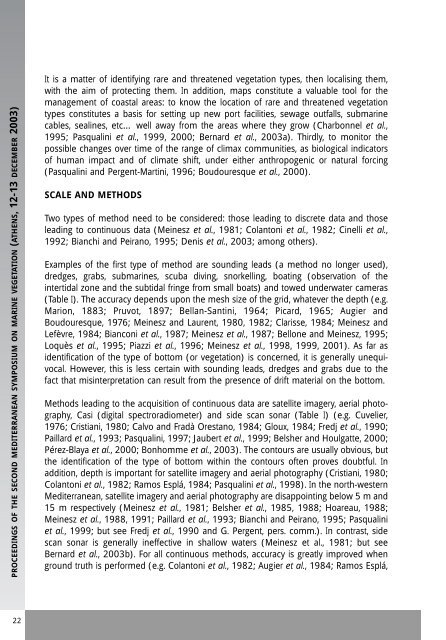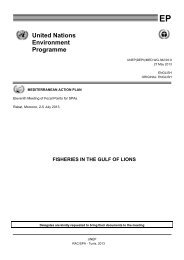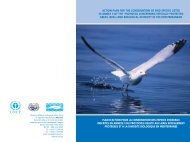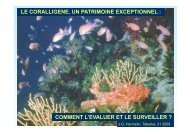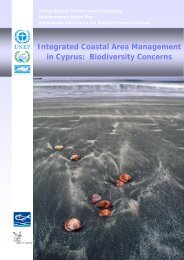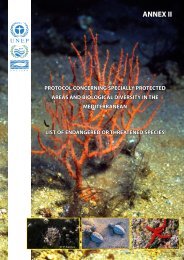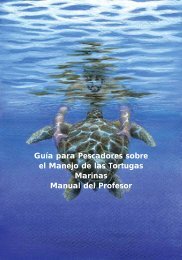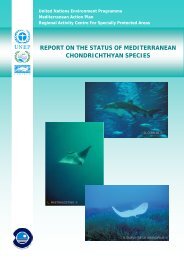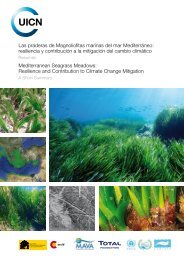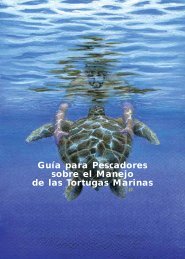Proceedings of the Second Mediterranean Symposium on Marine
Proceedings of the Second Mediterranean Symposium on Marine
Proceedings of the Second Mediterranean Symposium on Marine
You also want an ePaper? Increase the reach of your titles
YUMPU automatically turns print PDFs into web optimized ePapers that Google loves.
PROCEEDINGS OF THE SECOND MEDITERRANEAN SYMPOSIUM ON MARINE VEGETATION (ATHENS, 12-13 DECEMBER 2003)<br />
22<br />
It is a matter <str<strong>on</strong>g>of</str<strong>on</strong>g> identifying rare and threatened vegetati<strong>on</strong> types, <str<strong>on</strong>g>the</str<strong>on</strong>g>n localising <str<strong>on</strong>g>the</str<strong>on</strong>g>m,<br />
with <str<strong>on</strong>g>the</str<strong>on</strong>g> aim <str<strong>on</strong>g>of</str<strong>on</strong>g> protecting <str<strong>on</strong>g>the</str<strong>on</strong>g>m. In additi<strong>on</strong>, maps c<strong>on</strong>stitute a valuable tool for <str<strong>on</strong>g>the</str<strong>on</strong>g><br />
management <str<strong>on</strong>g>of</str<strong>on</strong>g> coastal areas: to know <str<strong>on</strong>g>the</str<strong>on</strong>g> locati<strong>on</strong> <str<strong>on</strong>g>of</str<strong>on</strong>g> rare and threatened vegetati<strong>on</strong><br />
types c<strong>on</strong>stitutes a basis for setting up new port facilities, sewage outfalls, submarine<br />
cables, sealines, etc… well away from <str<strong>on</strong>g>the</str<strong>on</strong>g> areas where <str<strong>on</strong>g>the</str<strong>on</strong>g>y grow (Charb<strong>on</strong>nel et al.,<br />
1995; Pasqualini et al., 1999, 2000; Bernard et al., 2003a). Thirdly, to m<strong>on</strong>itor <str<strong>on</strong>g>the</str<strong>on</strong>g><br />
possible changes over time <str<strong>on</strong>g>of</str<strong>on</strong>g> <str<strong>on</strong>g>the</str<strong>on</strong>g> range <str<strong>on</strong>g>of</str<strong>on</strong>g> climax communities, as biological indicators<br />
<str<strong>on</strong>g>of</str<strong>on</strong>g> human impact and <str<strong>on</strong>g>of</str<strong>on</strong>g> climate shift, under ei<str<strong>on</strong>g>the</str<strong>on</strong>g>r anthropogenic or natural forcing<br />
(Pasqualini and Pergent-Martini, 1996; Boudouresque et al., 2000).<br />
SCALE AND METHODS<br />
Two types <str<strong>on</strong>g>of</str<strong>on</strong>g> method need to be c<strong>on</strong>sidered: those leading to discrete data and those<br />
leading to c<strong>on</strong>tinuous data (Meinesz et al., 1981; Colant<strong>on</strong>i et al., 1982; Cinelli et al.,<br />
1992; Bianchi and Peirano, 1995; Denis et al., 2003; am<strong>on</strong>g o<str<strong>on</strong>g>the</str<strong>on</strong>g>rs).<br />
Examples <str<strong>on</strong>g>of</str<strong>on</strong>g> <str<strong>on</strong>g>the</str<strong>on</strong>g> first type <str<strong>on</strong>g>of</str<strong>on</strong>g> method are sounding leads (a method no l<strong>on</strong>ger used),<br />
dredges, grabs, submarines, scuba diving, snorkelling, boating (observati<strong>on</strong> <str<strong>on</strong>g>of</str<strong>on</strong>g> <str<strong>on</strong>g>the</str<strong>on</strong>g><br />
intertidal z<strong>on</strong>e and <str<strong>on</strong>g>the</str<strong>on</strong>g> subtidal fringe from small boats) and towed underwater cameras<br />
(Table I). The accuracy depends up<strong>on</strong> <str<strong>on</strong>g>the</str<strong>on</strong>g> mesh size <str<strong>on</strong>g>of</str<strong>on</strong>g> <str<strong>on</strong>g>the</str<strong>on</strong>g> grid, whatever <str<strong>on</strong>g>the</str<strong>on</strong>g> depth (e.g.<br />
Mari<strong>on</strong>, 1883; Pruvot, 1897; Bellan-Santini, 1964; Picard, 1965; Augier and<br />
Boudouresque, 1976; Meinesz and Laurent, 1980, 1982; Clarisse, 1984; Meinesz and<br />
Lefèvre, 1984; Bianc<strong>on</strong>i et al., 1987; Meinesz et al., 1987; Bell<strong>on</strong>e and Meinesz, 1995;<br />
Loquès et al., 1995; Piazzi et al., 1996; Meinesz et al., 1998, 1999, 2001). As far as<br />
identificati<strong>on</strong> <str<strong>on</strong>g>of</str<strong>on</strong>g> <str<strong>on</strong>g>the</str<strong>on</strong>g> type <str<strong>on</strong>g>of</str<strong>on</strong>g> bottom (or vegetati<strong>on</strong>) is c<strong>on</strong>cerned, it is generally unequivocal.<br />
However, this is less certain with sounding leads, dredges and grabs due to <str<strong>on</strong>g>the</str<strong>on</strong>g><br />
fact that misinterpretati<strong>on</strong> can result from <str<strong>on</strong>g>the</str<strong>on</strong>g> presence <str<strong>on</strong>g>of</str<strong>on</strong>g> drift material <strong>on</strong> <str<strong>on</strong>g>the</str<strong>on</strong>g> bottom.<br />
Methods leading to <str<strong>on</strong>g>the</str<strong>on</strong>g> acquisiti<strong>on</strong> <str<strong>on</strong>g>of</str<strong>on</strong>g> c<strong>on</strong>tinuous data are satellite imagery, aerial photography,<br />
Casi (digital spectroradiometer) and side scan s<strong>on</strong>ar (Table I) (e.g. Cuvelier,<br />
1976; Cristiani, 1980; Calvo and Fradà Orestano, 1984; Gloux, 1984; Fredj et al., 1990;<br />
Paillard et al., 1993; Pasqualini, 1997; Jaubert et al., 1999; Belsher and Houlgatte, 2000;<br />
Pérez-Blaya et al., 2000; B<strong>on</strong>homme et al., 2003). The c<strong>on</strong>tours are usually obvious, but<br />
<str<strong>on</strong>g>the</str<strong>on</strong>g> identificati<strong>on</strong> <str<strong>on</strong>g>of</str<strong>on</strong>g> <str<strong>on</strong>g>the</str<strong>on</strong>g> type <str<strong>on</strong>g>of</str<strong>on</strong>g> bottom within <str<strong>on</strong>g>the</str<strong>on</strong>g> c<strong>on</strong>tours <str<strong>on</strong>g>of</str<strong>on</strong>g>ten proves doubtful. In<br />
additi<strong>on</strong>, depth is important for satellite imagery and aerial photography (Cristiani, 1980;<br />
Colant<strong>on</strong>i et al., 1982; Ramos Esplá, 1984; Pasqualini et al., 1998). In <str<strong>on</strong>g>the</str<strong>on</strong>g> north-western<br />
<str<strong>on</strong>g>Mediterranean</str<strong>on</strong>g>, satellite imagery and aerial photography are disappointing below 5 m and<br />
15 m respectively (Meinesz et al., 1981; Belsher et al., 1985, 1988; Hoareau, 1988;<br />
Meinesz et al., 1988, 1991; Paillard et al., 1993; Bianchi and Peirano, 1995; Pasqualini<br />
et al., 1999; but see Fredj et al., 1990 and G. Pergent, pers. comm.). In c<strong>on</strong>trast, side<br />
scan s<strong>on</strong>ar is generally ineffective in shallow waters (Meinesz et al., 1981; but see<br />
Bernard et al., 2003b). For all c<strong>on</strong>tinuous methods, accuracy is greatly improved when<br />
ground truth is performed (e.g. Colant<strong>on</strong>i et al., 1982; Augier et al., 1984; Ramos Esplá,


